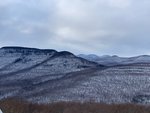
With one fire tower climbed toward the 2023 Catskills Fire Tower Challenge, I had occasion to play my daily hand with a hike to Overlook Mountain. Challenge or not, this mountain may eventually call to you if you don’t keep it in a regular hiking rotation. As part of the striking eastern escarpment of the Northern Catskills (or Wall of Manitou), Overlook is the closest in a profusion of peaks that greet visitors coming up the Hudson Valley.
Of all these visitors, perhaps it was Washington Irving who best spun a tale of how the Catskills first influenced his imagination and - through his writings - our imaginations. There is a passage by Irving that bears similarity to the opening of Rip Van Winkle where the mountains, their constant shifting in colors and ambience against the sky, seem to elicit corresponding effects in our mood, even to the point of casting a spell of ongoing curiosity. As a boy traveling up the Hudson on a sloop, he relates how an Indian trader described to him the tales of all the “hobgoblin places” as they slowly made their way upriver. “The Catskill Mountains, especially, called forth a host of fanciful traditions.” The entire quote is well worth seeking out, and we can only wonder how much poetic license is employed in embellishing the romanticism.
“All these [stories] were doled out to me as I lay on the deck, throughout a long summer’s day, gazing upon these mountains, the ever-changing shapes and bites of which appeared to realize the magical influences in question. Sometimes they seemed to approach, at others to recede; during the heat of the day they almost melted into a sultry haze; as the day declined they deepened in tone; their summits were brightened by the last rays of the sun, and later in the evening their whole outline was printed in deep purple against an amber sky. As I beheld them, thus shifting continually before my eye, and listened to the marvellous legends of the trader, a host of fanciful notions concerning them was conjured into my brain, which have haunted it ever since.” (Cited in The “Catskill Mountains and the Region Around” by Rev. Charles Rockwell, 1867 Chapter 11.)
It’s that last bit we can especially appreciate because the Catskills are a place that keeps our imaginations alive. The obvious move, then, is to pack up and go there – into the scene. They say Rip lived a bit to the north of Overlook, but the effect is the same. The hiker becomes positioned between the cultivated Hudson Valley far below and the wild, mountainous interior that’s calling you in. Reading in Rip Van Winkle how “For some time Rip lay musing on this scene...” and how he eventually gets called in, we recognize that the story enters the mythological realm. In a universal context, this stage in the rite-of-passage pattern of the story is the transition. What’s especially resonating is not only is this transition expressed through the experience of the place – the Catskills, but that this place has been preserved, keeping the story alive. In hiking the Catskills, we have the privilege of enjoying the same liminal condition, again and again.
Before getting into the woods, the topographical transition (from Woodstock) entails a climb (presumably of the vehicular sort) of some 1200’ to the Overlook Mountain Trailhead at the crest of Meads Mountain Road. Due to the popularity of this hike, a second parking area was built six years ago, a half mile to the north on Macdaniel Road. The Mead’s Meadow Trail connects the newer lot with the main trailhead and features three primitive campsites on adjacent trails. The project was made possible by a combination of regional advocacy efforts, funding from New York state, administrative work and funding from the Catskill Watershed Corporation, and construction work by NYS DEC. Increasing capacity of parking areas is one of several efforts in helping to make the Catskill Park a safe and welcoming environment for residents and visitors.
A series of related strategies have been set forth in the recently released Catskill Advisory Group Final Report (www.dec.ny.gov/press/126917.html).
The beginning of the 2.5-mile, 1400’ ascent to the summit was marked by the expected packed down snow from the recent nor’easter. With some high March sun softening the snow on this ever-ascending road, one kid had the right idea by doing repeats on his plastic saucer sled. Typically, you will encounter a full range of recreationists on this hiker highway, with many of them well dressed for shopping on Tinker Street. Their enthusiasm is admirable, but the preparedness can be on the light side. Though I march steadily upward with poles and mircrospikes, I recall the days of ‘bare-booting’ it, and ‘patching out’ with just about every step. Eventually, persistence pays off for the hiker as the concrete silhouette of the hotel remnants comes into view. Though this structure was at least the third hotel on the mountain, it never opened, and the land was sold to New York state.
On the way up, I chatted with several people who had never been up the mountain and fire tower, and I enjoyed witnessing their exalted reactions as they climbed the stairs. The same cold winds that prompted their departure from the structure somehow soothed me for an extended moment near the top of the tower. My gaze surfing laterally across the gentle rounded slopes, that welcoming feeling of repose slides in for a visit. That’s it, just a peaceful interlude, maybe even a daydream, and I’m poised for the return.
Peter Manning is the executive director of the Catskill Mountain Club. To learn about CMC events, membership, and projects visit catskillmountainclub.org.